
VOL. 10 NO. 4, 2024


2021PGSA30 A SALVATION ARMY GIFT ANNUITY OR CHARITABLE TRUST CREATES A GIFT THAT PAYS YOU INCOME FOR LIFE! OUR GIFT ANNUITY CAN PROVIDE Income for life at an attractive rate* A tax deduction Tax-free income The joy of helping those in need Peace of mind because we’ve never missed a payment *e.g., at age 75, the payment rate is 5.4%, and at age 85, the rate is 7.6%. The State of New York requires lower rates but our Gift Planners will suggest other options. 845.620.7297 TSALegacy.org
WHO WE ARE | 6|
People From teaching to giving haircuts, Captain Kendall Stout’s ministry is a call to love others.
| 7|
Programs Salvation Army
Envoy George Bates and Soldier Seth Hall bring Bible study to Zanesville prisoners. Plus: Verses on ministry in jail.
| 8|
History In times of war, Salvationists courageously serve their fellow humans.
| 10|
Faith in Action
The Salvation Army’s response to Vermont’s historic floods in July 2023 began with listening.
RECOVERY
| 14|
Testimony
Mark Laverriere once looked to alcohol for happiness, but those days are long gone.
FEATURE
| 22|
Fostering God’s Children
By becoming a foster parent, you can change a child’s life.
LIVING
| 28|
Spiritual Life Development
What do you do when you feel mad? Or sad? Or afraid?
| 30|
Book Review A foster mother shares her challenges and rewards.
| 31|
Health Ten tips to make this summer the healthiest yet.
| 32|
Volunteer Spotlight
Deborah Kazar helps make the Army’s Western Pennsylvania Fabric Fair a success.

27 Thrift
your summer days with outdoor gear from your local Salvation Army thrift store. 16 Cover Story Artificial intelligence is all the rage. Should Christians use this new technology? 3 From the Editor 5 Who We Are LU LU RIVERA 1 SACONNECTS.ORG CONTENTS VOLUME 10 NUMBER 4 COVER: ISTOCK; DREAMSTIME
Store Finds Brighten

THE SALVATION ARMY’S OTHERS PROGRAM OFFERS PEOPLE IN OTHER COUNTRIES
MORE ACCESS TO FLEXIBLE JOBS, FAIR WAGES, AND DECENT EMPLOYMENT. THROUGH YOUR PURCHASES, WE PROVIDE LIFE–CHANGING OPPORTUNITIES TO OVER 1200 ARTISANS IN DIFFERENT PARTS OF THE WORLD WHO PRODUCE QUALITY HANDMADE PRODUCTS, LIKE THIS SISAL CROSSBODY BAG, HANDWOVEN IN KENYA.


To see all of our products and learn more about our mission, visit www.tradeforhope . com
HOPE. INDEPENDENCE. DIGNITY.
FOUNDER William Booth
GENERAL Lyndon Buckingham
TERRITORIAL LEADERS
Commissioner Ralph Bukiewicz
Commissioner Susan Bukiewicz
CHIEF SECRETARY Colonel Ivan K. Rock
DIRECTOR OF INTERNAL COMMUNICATIONS
Joseph Pritchard
EDITOR IN CHIEF / DIRECTOR OF PUBLICATIONS
Warren L. Maye
MANAGING EDITOR Robert Mitchell
EDITOR / HISPANIC CORRESPONDENT
Hugo Bravo
COPY EDITOR / PROOFREADER Donna L. Ng
ART DIRECTOR Reginald Raines
PUBLICATION CONTENT
MANAGER AND DESIGNER
Lea La Notte Greene
GRAPHIC DESIGNERS
Dave Hulteen Jr., Joe Marino, Karena Lin
STAFF PHOTOGRAPHER Lu Lu Rivera
CIRCULATION Doris Marasigan
THE SALVATION ARMY MISSION STATEMENT
The Salvation Army, an international movement, is an evangelical part of the universal Christian Church. Its message is based on the Bible. Its ministry is motivated by the love of God. Its mission is to preach the Gospel of Jesus Christ and to meet human needs in His name without discrimination.
Member since 2015. Award winner 2016, 2017, 2019, 2020, 2021, 2022, 2023, 2024
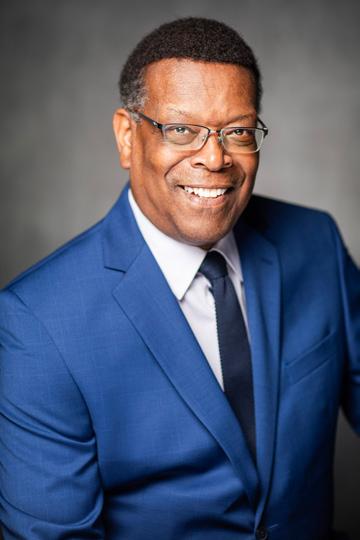 WARREN L. MAYE Editor in Chief
WARREN L. MAYE Editor in Chief
Diane was a foster child, but to me, she was my courageous cousin. She visited me when I, as a child myself, was extremely sick. That day, she opened the door to my room, walked in, and sat in a chair near the door, away from my bed.
“You shouldn’t be in here. You might catch it,” I said to her.
“I just came to say hello.” Her eyes showed more concern for me than for herself. “How are you feeling?” she asked.
I let some toys fall to the floor and propped myself up the best I could. “Bored. They won’t let me out.”
“That’s because you’re sick and you need to get well, Warren.”
To this day, I remember how good it felt to hear her caring voice. I had no idea just how bad strep throat and scarlet fever could get. But after two weeks in quarantine, I went looking for my best friend, Robert, who had also gotten sick. That’s when I discovered he had died. When I tried to call Diane to talk about it, I learned she’d been moved to another family. Despite my best effort to find her, I never saw her again.
NY 10994–1739. Vol. 10, No. 4, 2024. Printed in USA. Postmaster: Send all address changes to: SAconnects, 440 West Nyack Road, West Nyack, NY 10994–1739. SAconnects accepts advertising. Copyright © 2024 by The Salvation Army, USA Eastern Territory. Articles may be reprinted only with written permission. All scripture references are taken from the New International Version (NIV) unless indicated otherwise.

“Jesus said, ‘Let the little children come to me, and do not hinder them, for the kingdom of heaven belongs to such as these.’”
—Matthew 19:14
That’s how life can be for kids in foster care who dream of being adopted. They suddenly find themselves in yet another home, starting over. Simone Biles, the most decorated gymnast in history, was a foster child until her grandfather adopted her. Now, her story offers hope to nearly 400,000 children in foster care in the United States.
In this issue of SA connects, we’re shining a light on what The Salvation Army is doing to help bring stability to kids standing on the balance beam of life. You’ll read stories of foster-care parents who’ve shared their homes and children who were adopted.
You’ll also read about the potential of artificial intelligence, AI, to negatively or positively influence our future. Did you know that foster-care social workers are using AI-powered tools to help manage cases, track progress, and identify resources for families? Such tools are also providing mental and emotional health support through chatbots and virtual assistants, which offer counseling to children and foster families.
God willing, one day I might even use AI to find Diane.
3 FROM THE EDITOR www.saconnects.org | @saconnects SAconnects is published by The Salvation Army USA’s Eastern Territory. Bulk rate is $12.00 per issue for 25–100 copies. Subscriptions are available. Write to: SAconnects, The Salvation Army, 440 West Nyack Road, West Nyack,
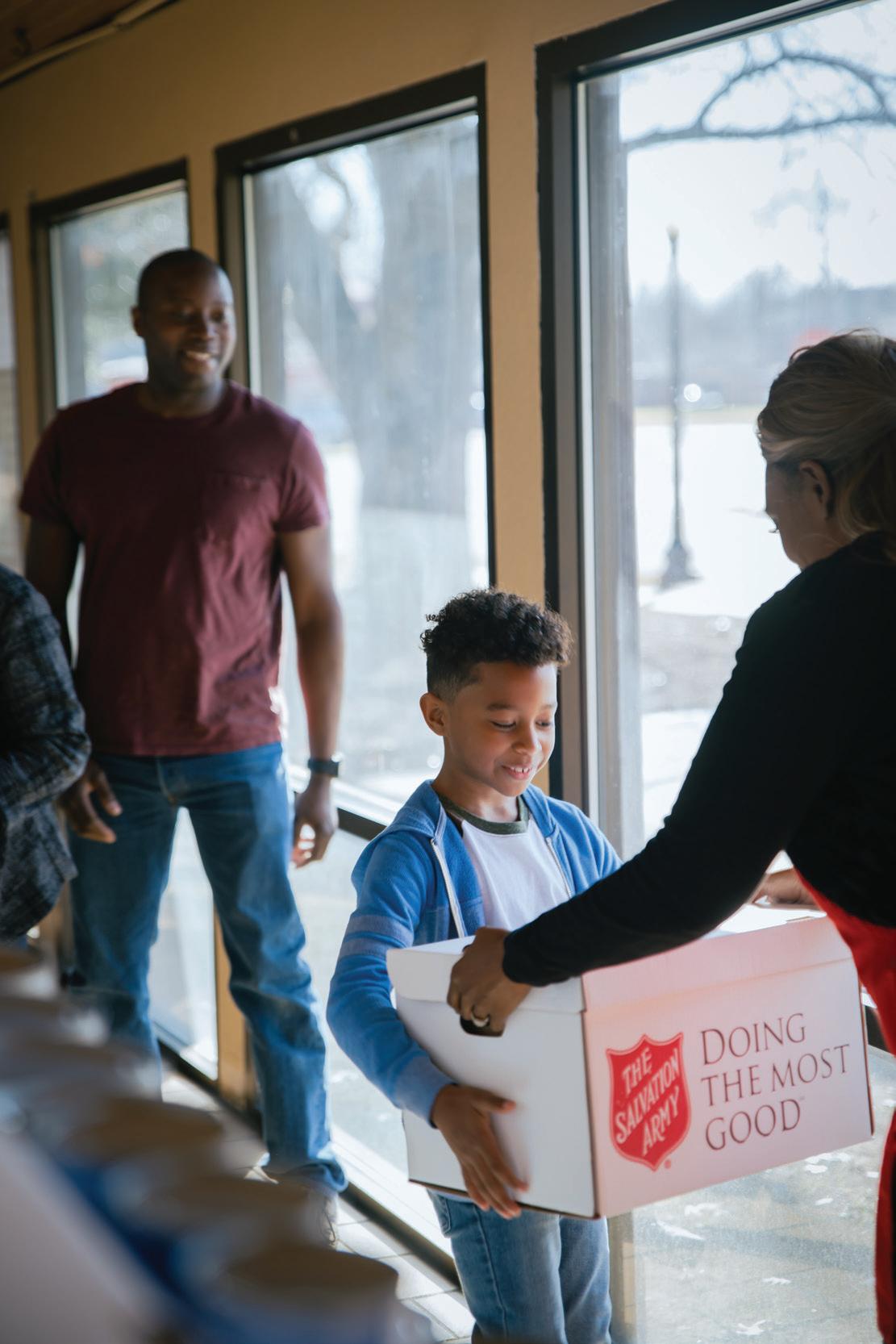
Love Be yond
Surging Prices
Food pantries . Warm meals. Sack lunches.
e goal of e Salvation Army’s Love Beyond campaign is to increase public awareness of our year‒round services. We love beyond hunger, homelessness, destruction, fear, loss, loneliness, despair, overdue bills, and so much more. We love beyond the circumstances of those we serve, seeing and valuing each person.

WHO WE ARE

“ Donor Corner

Jet’s Pizza, known for its signature square deepdish Detroit-style pizza, has provided food for various Salvation Army programs and services in the central Ohio area, such as after-school learning centers, summer camps, and other youth activities. The pizza chain, which has 425 franchises in 22 states, also supports the Army’s Angel Tree ministry at its central Ohio restaurants and gives “thank you” cards and free pizza to participants of The Salvation Army’s yearly LemonAiD fundraiser in Ohio.
“The Salvation Army is grateful to Jet’s Pizza for their tremendous support and dedication to help feed and provide for those in need in our community,” says Shelley Brown-Kujkowski, corporate and donor relations director for The Salvation Army in Central Ohio.
“Because of our wonderful partnership with Jet’s,” says Captain James Brennan, area coordinator for The Salvation Army in Southwest Ohio, “we are able to help more people find help and hope in times of need.”
Did you know?
In 1900, The Salvation Army in Norway owned a boat named the Catherine Booth after the Mother of The Salvation Army. The 50-foot ketch sailed to rescue fishermen and sailors, saving 1,172 boats and over 5,000 lives from being lost at sea. Another ministry known as the Viking fleet would travel to isolated villages and share the gospel.
Some men’s passion is for gold, some men’s passion is for art, some men’s passion is for fame.
My passion is for souls.
—FOUNDER WILLIAM BOOTH

Each August since 1935 (except during the COVID pandemic), The Salvation Army’s best young musicians have gathered at Star Lake Musicamp in the mountains of Bloomingdale, N.J., to hone their skills and deepen their walk with Christ.
”
© 1929 ERLING HOLST/MUSEUM NORD 5 SACONNECTS.ORG
LU LU RIVERA
Being Called to Love
Interview by HUGO BRAVO
Captain Kendall Stout, corps officer of The Salvation Army Lock Haven Corps in eastern Pennsylvania, talks about Bible sword drills, welcoming people who are homeless to the church, and how becoming a married partner in ministry will change the way she serves.
Two years ago, a large number of homeless people started coming to the Lock Haven Corps. We had made connections with local shelters, and their residents learned that here at the corps, they could receive daily meals and fresh coffee in the mornings. Also, the local shelter didn’t open for them until 6 p.m. So, I let the residents know that, any day they wanted to, they could stay here until we closed the building at 5 p.m.
Serving people who are forgotten by the community is my No. 1 ministry. So many of them are just simply down on their luck, and they’re all people who have lived interesting lives. We have TVs for them to watch, they can take trips to the thrift store for clothing, and we even want to see about installing a shower for them at the corps. I prepare their favorite meals, take their clothing home to wash, and even give them haircuts at the corps. I didn’t know how to cut hair before, but ministry and taking care of others comes in different ways, so I bought some clippers and taught myself. It was another way to serve.
After years of being away from the church, I came back to lead youth programs at my corps. That ministry was what drew me into The Salvation Army, and working with children has been part of each of my appointments. The Lock Haven Corps has an after-school program that transitions to a day camp in the summer. Many of the children come from broken homes or are without parents in their lives. But here, they can learn what love is. Being around kids keeps me young too. It’s the only time I can completely let go and be childish right along with them.
I don’t think I was specifically called to be a teacher and a preacher, although I am both of those today. But my calling is much simpler than that: God has called me to love others. That’s the overarching theme of everything I do, and it’s the very basis of all our ministries. Is it easy? Not always. But it is always a privilege to be in a position to show God’s love.
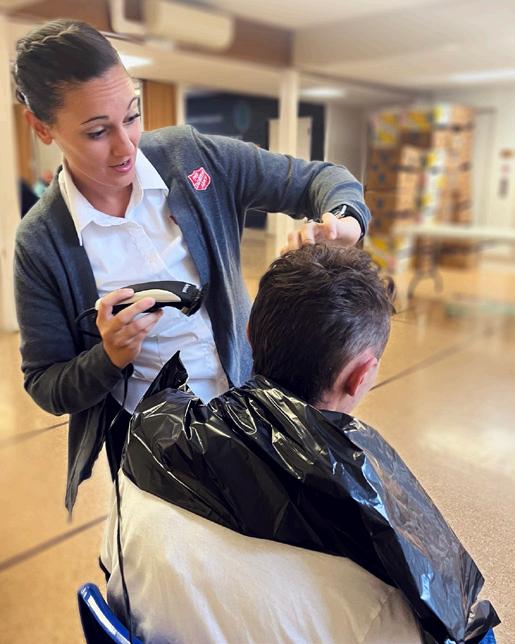
I remember not being great at school. Even while training to be an officer, I didn’t learn with complicated words and lofty ideas. Instead, I broke things down to a very general, digestible sense and learned from there. That’s how I teach others today, by taking Scripture and breaking it down in such a way that it is easily digestible and applicable to the people I’m teaching. I teach kids and adults, and sometimes those lessons can be very similar. For example, all ages enjoy doing “sword drills”— competitions to see who can find a verse in the Bible the fastest and read it aloud. It’s fast-paced and interactive, and it makes the Bible accessible down to the books, the chapters, and the verses. I don’t ever want the Word of God to be dull or hard to understand for anyone.
My husband, Richard, was just commissioned as a Salvation Army lieutenant this June. Being partners in ministry is a big adjustment. We’re two very different people! He grew up in India and came to the United States to become an officer; I’ve been a single corps officer in Pennsylvania for seven years. Richard has incredible book smarts. I’m more of a commonsense, street-smarts person. Splitting the responsibilities of running a corps is new for me. If the corps had holes in the walls or needed a new kitchen floor, I’d fix it myself. Having Richard by my side to share the work and make decisions (along with being newly married and possibly starting a family) is very exciting. We’ve both hit the reset button as pastors, and it’s going to be interesting to see what our ministry will look like in a few months.
COURTESY OF THE SALVATION ARMY LOCK HAVEN CORPS
SA Clippers
6 Volume 10 Number 4, 2024 WHO WE ARE PEOPLE
Captain Kendall Stout gives a haircut inside the Lock Haven Corps.

God’s Word Behind Bars
by HUGO BRAVO
Verses on ministry in jail
“Continue to remember those in prison as if you were together with them in prison, and those who are mistreated as if you yourselves were suffering.”
—Hebrews 13:3
“I am suffering even to the point of being chained like a criminal. But God’s word is not chained.”
—2 Timothy 2:9
“About midnight Paul and Silas were praying and singing hymns to God, and the other prisoners were listening to them.”
—Acts 16:25
“Set me free from my prison, that I may praise your name. Then the righteous will gather about me because of your goodness to me.”
—Psalm 142:7
“I needed clothes and you clothed me, I was sick and you looked after me, I was in prison and you came to visit me.”
—Matthew 25:36
The men at Muskingum County Jail in Zanesville, Ohio, were at Bible study. Two participants whispered, as if each was trying to convince the other to speak up. They had just listened to Salvation Army Envoy George Bates and ministry assistant Seth Hall talk about the Book of Exodus, and how God told Moses that He would be with him as Moses set up his tent outside of the Israelite camp, where Moses could work and settle disputes.
“Once we have repented and received Christ, we simply cannot operate as we have in the past,” Hall explained. “We must separate ourselves from where we were before, and set our own tents outside of our familiar camps.”
One of the two men finally spoke. He said on the day before Bible study, they had discussed ways they could separate themselves from the destructive environments of their past.
Envoy Bates remembers that moment. “The guys were the two biggest, most tattooed ones in the class. Upon seeing them, you knew they were the last ones you’d ever want to mess with,” he says with a smile.
Hall, a soldier of the Zanesville Corps, recalls that time together as transformative. “When God’s Word appears with a message, it leaves the most hardened tough guys completely vulnerable, and sometimes even in tears.
“The Holy Spirit was here at work. Before class, in prayer, I felt that God wanted me to preach from the Book of Exodus that day.”
The Zanesville Corps jail ministry was inspired by a community program called the Muskingum County Opioid Response Team, of which Bates was a member. If someone in the community suffered an overdose and was given lifesaving naloxone (Narcan), the response team would send a police officer, a social worker, and a pastor to the person’s last known address and encourage them to seek help for their abuse problem.
“Before we even came across these people, many of them would first end up in jail,” says Bates. “It can be easy to say, ‘These guys are messed up; let’s just deal with them when they get out.’ That’s being stagnant. Those are missed opportunities.”
Bates reached out to the sergeant at Muskingum County Jail to ask how to acquire the proper credentials. Today, Bates and Hall visit the jail twice a month to share the Word of God with a community that needs to hear it.
“Most of the men we meet are felons waiting to be sentenced to prison. They have nothing but time to ponder the deep mysteries of life, such as our purpose in life, and where we go when we die,” says Hall. “There is nothing phony or ingenuine about their thoughts. And when you give them a devotional from the Bible and go line by
line with them, it springboards into some amazing, heartfelt conversations.”
Bates says, “This is different than preaching inside a church. On some Sundays, no one wants to approach the altar, because they don’t want to give the impression that they’ve sinned. They fear what others will think of them. But a broken person will not care what anyone thinks. They’re honest about themselves, even in front of their peers. Many of the broken men we meet grew up in Christian homes and know of Christ. That’s what blows my mind: not what we have to teach them, but rather how much they already know and are open to share.”
These exchanges are also a crucial step toward receiving help. When someone asked one of the participants what he would do if he could walk out a free man that day, his answer was both truthful and heartbreaking.
“He said that he knew that he had to be in jail, because if he left, he would go to his mother’s house. There, he could easily go back to abusing drugs,” says Bates. “I gave him our contact information to call us if he got out, so we could get him help. If he needed to be picked up, we would pick him up. If he needed several months of rehab to get clean, we would find a program for him.”
“Scripture talks about the importance of what you do in the unseen, that secret place where you are not seeing or receiving your own reward in full. I will never see how far the work we do in jail can reach. For me, that’s one of the best things about this ministry,” says Hall.
“This outreach is not something that everyone can do, but I would still tell anyone to give it a chance,” says Bates.
“When you see a face the moment that the gospel suddenly clicks for them, it’s worth every minute of your time to be a part of this ministry. It may not change the world, but it can change someone’s life.”
ISTOCK 7 SACONNECTS.ORG WHO WE ARE PROGRAMS
Agents of Peace in Times of War
Salvationists have served through wars and conflicts, and their stories are important to tell, particularly for those of us who’ve only known stability
by ROB JEFFERY
In the Salvation Army church of my youth in Canada, a gentleman named Erik came into the church well into his senior years. As I got to know him, I remember him speaking in his strong Dutch accent, even though he had lived in Canada for many years. He shared that as a teenager he had served in the Dutch Resistance, a group that actively resisted the Nazi occupation of the Netherlands from 1940 to 1945. Through his work in this group, he had seen some horrible things—man’s inhumanity toward man.
I know of a Salvationist who grew up in Northern Ireland during the 1970s and ’80s who witnessed the extreme sectarian violence known as the “Troubles.” Decades later, the smell of diesel fuel and smoke takes her mind right back to the turmoil.
When I was serving in active church ministry, a woman entered our fellowship who was a refugee from Rwanda. She was filled with the joy of the Lord and always seemed to be smiling, but behind that smile was the sadness of seeing her child murdered during the Rwanda genocide. And even more recently in my church in Spring Valley, N.Y., we listened with great concern as our Haitian members told us in a Sunday morning meeting of the many horrors they escaped when they fled their home country to live in the United States.
A military metaphor
Both past and present, The Salvation Army has operated in countries torn apart by war and has always risen to meet the needs of the moment. Think of the “Donut Girls” of World War I—these American Salvation Army officers volunteered to serve U.S. military personnel fighting in France. With motherly devotion, they operated those donut huts faithfully and at great risk to
themselves from 1917 until the early 1920s, when the remaining troops were sent home. On the other side, the German Salvation Army, though diminished by the war, tried to meet its members’ needs through similar efforts. The “heart to God, hand to man” approach of The Salvation Army knows no enemy. All can be served in love.
Yes, its very name is based on a military metaphor, and The Salvation Army’s support of the armed forces community is without question. But the reality of war and human conflict has always been seen as tragedy. Founders William and Catherine Booth were subjects of Queen Victoria’s British Empire, which had control over many countries with resulting conflicts, yet the Booths never seemed to be pro-empire or to take on the jingoistic mood of the times.
William Booth thought it was monstrous that human beings should be sent to war. In an article from 1885, “The Possibility of War with Russia,” he wrote the following impassioned plea:
“What is the duty of Salvationists at such a crisis? … One thing is plain—every true soldier of The Salvation Army should cry night and day to God to avert so dreadful a calamity. Let him shut his ears to all the worldly, unscriptural, unchristian talk about war being a necessity. It cannot be a necessity before God that tens of thousands of men should be launched into eternity with all manner of revengeful passionate feelings in their souls. … Whatever may be the right method of settling human disputes and preventing earthly calamities, this cannot be the Divine plan. This cannot be the will of God.”
In 1878, Commissioner George Scott Railton noted the human propensity for
war in an article called “Peace or War?” He wrote: “There will be wars—not only one but many, as long as this wretched world continues. The war-fever will spread its deadly contagion, century after century, amongst people after people, until the sword has reaped its horrid harvest out of every homestead and desolated every family in every land.”
How sadly prophetic.
Fighting for peace
So, while The Salvation Army does not have a formal expression of pacifism in the same way some Christian communities do (the Quakers and the Anabaptists, for instance), we have a desire to fight for peace in our everyday work as Salvationists. As soldiers we fight for peace in our communities by showing love and acts of kindness. We fight for peace by bringing healing and reconciliation to peoples beset by enmity and strife. This is the only way that our metaphor of an Army makes sense.
Ephesians 6:12 affirms, “For our struggle is not against flesh and blood, but against the rulers, against the authorities, against the powers of this dark world and against the spiritual forces of evil in the heavenly realms.”
In many conflicts, Salvationists have stood out as agents of peace. During World War I, while Evangeline Booth was sending brave young officers over to France to minister to American troops, her brother General Bramwell Booth was in London struggling to keep the global Salvation Army united. After the war, Bramwell upset some Army supporters when he committed resources to war-ravaged Germany.
“Why help our enemy?” some asked. Bramwell, rock-solid in his convictions that
8 Volume 10 Number 4, 2024 WHO WE ARE HISTORY
MOBILIZED
A Salvation Army mobile canteen serves Canadian troops who took part in an exercise to test London’s air defenses in July 1941 during World War II.

The Salvation Army was not to be confined by narrow nationalism, said, “Every land is my fatherland, for all lands are my Father’s.”
During World War II, General George Carpenter refused to allow the word enemy to appear in any Salvation Army publication. Conscious of the power of words to stir up hate, Carpenter did not want Salvationists thinking of their fellow human beings as enemies, despite the actions of their governments.
Babies in a basket
In that same conflict, then-Captain Alida Bosshardt hid Jewish babies in her bicycle basket and drove them around Amsterdam to various safehouses. Such bravery from a young officer!
Salvationists have often paid a steep price for living out their faith and witness
in times of fighting. Commissioner Herbert Lord was arrested and jailed first by Japanese authorities in World War II, and for a second time by North Korean authorities in the Korean conflict. Even in jail, he ministered to the people under his care.
According to General Shaw Clifton in his book Who Are These Salvationists? during times of human warfare The Salvation Army has focused on evangelism among members of the military community, compassionate action (meeting human need), and political neutrality.
In our present day, we find ourselves living in a world torn apart by war. While only two or three may be in the focus of Western media at any given time, there are literally dozens of conflicts, varying in size and intensity, raging around the world as you read these words. Worship leader
Graham Kendrick wrote these hopeful lyrics found in The Song Book of The Salvation Army (No. 998) about a glorious future in God’s coming kingdom without war:
Refuge from cruel wars, havens from fear, Cities for sanctuary, freedoms to share.
Peace to the killing-fields, scorched earth to green, Christ for the bitterness, His cross for the pain.
God of the poor, friend of the weak, Give us compassion we pray.
Melt our cold hearts, let tears fall like rain; Come, change our love from a spark to a flame.
May we be inspired by our godly heritage to be agents of peace in a world at war.
Rob Jeffery is director of the Heritage Museum in the USA Eastern Territory.
KEYSTONE PRESS / ALAMY STOCK PHOTO 9 SACONNECTS.ORG
A U.S.

WHO WE ARE FAITH IN ACTION
The Great Vermont Flood
Air National Guard photo captures extensive flooding in Vermont’s capital city of Montpelier from a July 2023 storm system that inundated broad swaths of the Northeast.
Praising God Through the Storm
During the worst flooding disaster Vermont had seen in decades, pastors Keith and Katherine Jache led recovery efforts in the name of God and The Salvation Army
by HUGO BRAVO

When Major Keith Jache talks to cadets at The Salvation Army College for Officer Training, he shares a crucial piece of advice to those men and women who will one day be pastors, likely in communities far from their hometowns.
“When you arrive at your new assignment, there are certain people you should seek out and get to know immediately. Of course, people like the mayor are important but also town management workers like the local fire chief. In a disaster situation, that’s the person who is going to be in charge,” says Major Keith.
He understands this from experience. In July of 2023, he and Major Katherine Jache had been the corps officers at the Barre, Vt., Salvation Army for a little over a year. That month, the northeastern United States experienced heavy rainfall and destructive flash floods. Vermont was one of the states most affected. Montpelier, its capital city, just a few miles to the northwest, had its busy downtown area heavily flooded. Residents were left stranded and their properties destroyed.
“We had seen flooding and even tornadoes while serving in Pennsylvania before, so this wasn’t something we were unfamiliar with. But the scope of it was just tremendous. The damage was devastating,” says Major Keith. “I’d also done Emergency Disaster Services with The Salvation Army in the past, so I knew who and what EDS would need. The groundwork was already there for them when they arrived because I had made those connections early on. I knew the town management, and they knew how The Salvation Army can help in these situations.
“Before every encounter with people who had been affected, I prayed to God to give me the words to say to them, because I didn’t have them myself.”
His hands and feet
With the connections made by Major Keith, The Salvation Army hit the ground running. They worked with Enough Ministries, a local church, to deliver food, cleanup kits, and gift cards. Eventually,
APFOOTAGE / ALAMY STOCK PHOTO 11


Delivering Comfort
During the early recovery efforts, listening was the greatest service
The Salvation Army could provide.
“That’s how you first learn where the need is. But also, many just wanted to tell us their stories. They wanted someone there with them to know that they were not alone,” says Major Keith Jache.
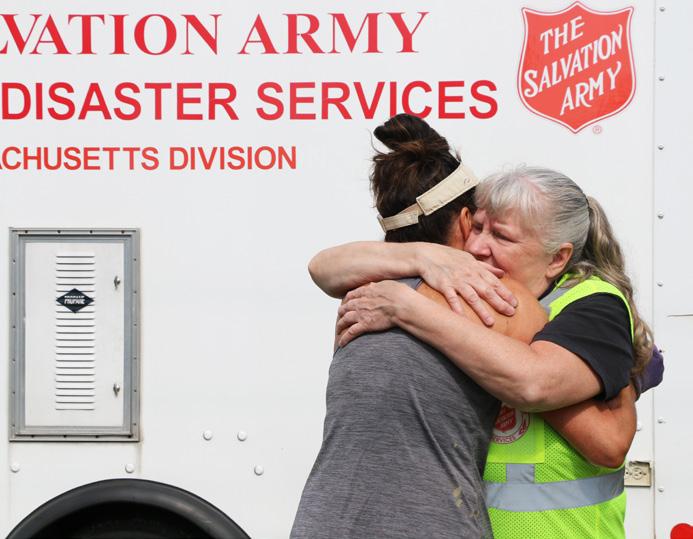
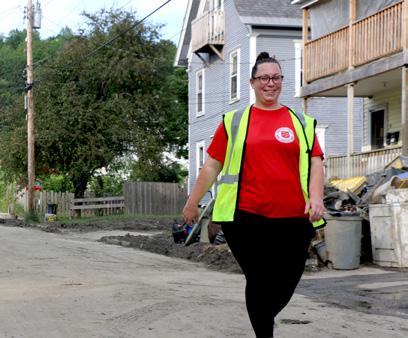
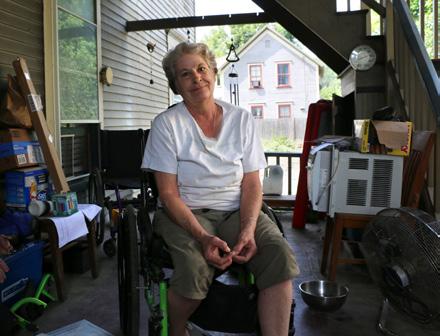


MICHAEL BALDELLI/THE SALVATION ARMY SOUTHERN NEW ENGLAND DIVISION
12 Volume 10 Number 4, 2024
“Before every encounter with people who had been affected, I prayed to God to give me the words to say to them, because I didn’t have them myself.”
—Major Keith Jache
all assistance efforts shifted to the Barre City Auditorium, a multipurpose arena that could host feedings and even be a place of spiritual and emotional care for the community. This was a time for The Salvation Army to go out and be God’s hands and feet to the people.
“There was a man who would push his wheelchair-bound girlfriend up a hill every day so they could both get food. On a day that it rained heavily, I helped him push,” says Major Keith.
“We met a woman who’d been stranded on the second floor of her home and lost all her pets in the flood,” says Major Katherine. “She was so frail and heartbroken, but she didn’t want anything from us—just someone to listen to her and her pain. The ministry of presence is very important in times like these.”
Then there was Gary, a father who’d just bought a house in Vermont so he could live next door to his daughter. Both lost their homes. Two days later, Gary’s son, who lived in Arizona, died.
“Gary had no idea how he could possibly handle what he was going through in Vermont and bring his son home at the same time. Through the corps, we were able to make arrangements to get his son’s body cremated and brought to Gary, fully paid for,” says Major Keith. “It was a blessing for us that in the midst of all this chaos and sadness, we were able to help a father in a way that we weren’t expecting.”
A homemade church
With both the Barre Corps and its Salvation Army thrift store impacted by the storm, the Jaches did not have a building to use on Sundays. But as unique ministries tend to rise up in unorthodox situations, so do
ways to adapt and bring comfort to others.
“We lived on a hill. Our own living quarters weren’t damaged much. So for about a month and a half, we had worship services in our home,” says Major Katherine. “That first Sunday was more of a grieving session. Many people were frustrated, sad, or angry at the process it would take to recover what they had lost. At the same time, we talked about how each of us were helping our neighbors and what we needed to do going forward. Then we set time aside to pray and sing some songs.”
That time deeply impacted the officers. In the small space, says Major Katherine, the worship and praise “sounded different, more powerful and meaningful.”
When people are going through such loss, it can feel natural to approach them with a verbal message of Christ’s love. But the pastors saw that sometimes it’s better to come with open eyes and ears and be receptive to pain and grievances.
“Whether it’s listening to their situations or sitting down and going through a FEMA form with them,” says Major Keith, referring to the Federal Emergency Manage ment Agency, “people need to know they’re not alone in times like these.”
“Jesus picked people up first and consoled them through their suffering,” Major Katherine says. “After that, He said to them ‘go and sin no more.’ If someone has lost everything they have, and the first thing you give them is Scripture, they’re not going to see you as a source for help. They’re going to see you as someone just trying to get another number on a statistics board. Letting people express their pain to you is a way of showing the love of Jesus in itself. After that is when the conversations and prayer requests will come.”
The long term Months after the floods, hundreds of houses in Vermont are still being reconstructed. Boilers and furnaces need to be relocated to higher floors to avoid future damage. These are costly procedures not every family can afford. The state government has discussed creating green spaces along bridges for flood runoff.
“The problem is that there are houses along those areas,” says Major Keith. “People live there because it’s less expensive. Long term, it may create more unhoused people and communities.”
In the spring, the Jaches were transferred to The Salvation Army in Portland, Maine.
“We trusted God in the move, but at the same time, we felt like our work was unfinished,” says Major Keith. “In the first few months of recovery from a disaster, everyone kind of works in a fog. It’s after some time has passed that you really understand what the necessary long-term tools are.”
“It just so happened that around the time of the move,” says Major Katherine, “my mother was having major surgery in, of all places, Portland, allowing us to be close to her. God worked His plan, even though we didn’t know what our future would be.”
Like recovery from disasters, the Lord’s plans and promises are always working over the long term. Just as their experience from serving in Pennsylvania helped the Jaches in Vermont, so will their Vermont experience help them in Portland.
Recently, Major Keith received a call from one of the FEMA workers he met in Barre. “Portland had just received some funding,” says Major Keith, “and FEMA wanted to work with us to see what the city could do to avoid coastal flooding and prepare for their next storm.”
13 SACONNECTS.ORG

They’re All Good Days Now
Once lost to alcohol and drugs, Mark found humility and happiness through Christ
by ROBERT MITCHELL
A Christian path
Salvation Army Adult Rehabilitation Centers, or ARCs, are nonclinical facilities that serve individuals with a variety of problems, including those who have faced challenges with alcohol and drugs. How can they help?
“This ARC here and the entire experience, I would highly recommend it for anybody who is struggling,” says Mark Laverriere. “I’ve tried rehabs that were scientific and medicalbased. They didn’t work for me. This Christian program was amazing. The way the administrator, Envoy Taylor, operates this place is impressive. I can’t say enough about the ARC. I owe a great debt to this place. I’m alive because of this place.”
“Therefore, if anyone is in Christ, the new creation has come: The old has gone, the new is here!”
—2 Corinthians 5:17
Mark Laverriere was the life of the party when he drank alcohol. After a few drinks, he was funny and engaging, and his shyness disappeared. He felt good about himself and had a false sense of ego and pride. Even talking to women came easy.
Today, however, Mark says, “Alcohol gave me all those things that I thought I was missing, but then it took from me everything that I needed—family, friends, happiness.” Sitting in The Salvation Army’s Adult Rehabilitation Center (ARC) in Portland, Maine, where he is the resident manager, he continued, “I didn’t like my life when I was sober. I didn’t like how I felt about myself. Alcohol and drugs were a solution to that. They were an escape.”
Mark, who grew up in nearby Biddeford, began experimenting with alcohol at 13 and later sank to using heroin. All the while, he was able to maintain a job, mostly because he owned his own drywall hanging company. He married his high school sweetheart, but once that marriage failed, he buried himself deep in alcohol and drugs.
In late 2021, Mark was on suicide watch at a local hospital when a nurse suggested he try The Salvation Army’s ARC program. The six to nine months to complete the program seemed drastic, “but a drop in the bucket compared to the rest of my life,” Mark says. He arrived in January 2022 with virtually no religious faith.
“I didn’t want to come here, but I was willing to give it a try and it was one of the greatest decisions I ever made,” Mark says. “God gave me the gift of humility and desperation that allowed me to walk through those front doors.
“I held on to those gifts of humility and desperation, and that kept me hungry this time. This place gave me opportunities that I didn’t have out there. It took the distractions away for me and I was able to just focus on myself and allowed me to build a relationship with God.”
Mark, 45, began working through the
ARC program (he wrote 750 pages about his life) and attending chapel, where he became a believer in Jesus Christ. The change “almost happened instantly” and he found freedom, thanks to the staff, counselors, and Envoy Stephen Taylor, the ARC’s former administrator.
“When that man puts his hand on you and prays over you, you feel it,” Mark says. “He has such a spiritual vibe and a servant’s heart. I don’t think there’s one time I didn’t tear up when he prayed over me.
“Once I accepted Jesus Christ as my Lord and Savior, this whole 30 months of sobriety, I have not had one bad day. I truly feel free, but I have to work at it every day.”
Now, instead of a bottle, Mark cracks open a Bible and starts his days on his knees in prayer.
“I feel good about myself now,” he says. “I hated looking at myself when I was out there. Now I’m proud of myself and how far I’ve come. I worked my butt off in here.”
Since graduating from the program in September 2022 and becoming the resident manager, living at the ARC, Mark says, “I don’t want to go anywhere else.”
He sees a lot of himself in the men who come in, and he often reaches out to help them if he can.
“I always want to be around people trying to get sober,” he says. “I want to have a positive impact on as many people as I can. All I did my whole life was take. Now that I’m on this different way of living, it’s time to give back daily as much as I can.”
The big change from his past attempts to turn his life around—which always ended in failure—is that Mark now puts Christ first in all he does.
“Christ is everything to me,” Mark says. “He’s my Siri, He’s my Google, and my GPS through life. I lived my life in [spiritual] darkness and in dark places. Now I choose to live my life in the light of God’s grace, and I truly feel that grace working in me every day.”
LEAH CARTER 15 SACONNECTS.ORG RECOVERY TESTIMONY


What is artificial intelligence? Should Christians fear or embrace this emerging technology?
AI: Friend or Foe?
by ROBERT MITCHELL
The mere mention of artificial intelligence, or AI, conjures up images of a high-tech, dystopian time when machines mimic humanity and take over the world, but the truth is, many elements of AI have been around for a while.
“Every single person uses artificial intelligence throughout their day whether they realize it or not,” Jason Thacker, author of the books The Age of AI and Following Jesus in a Digital Age, told SA connects
“AI is built into so many of our modern technologies, from cellphones to smart devices to email to online shopping,” Thacker said. “In many ways it makes our world very convenient and very personalized.”
Kenny Jahng, founder of AIforChurchLeaders.com and editor-in-chief of ChurchTechToday.com, told SA connects that AI is “like a computer program that mimics human intelligence. It learns from data, makes
ISTOCK 17
decisions, and can perform tasks usually requiring human brainpower.”
The universal Church was initially cool but eventually warmed up to emerging technologies like the printing press, newspapers, radio, television, and even the internet and social media. In more recent years, Christian tech leaders are saying that AI is not inherently good or bad and could be a valuable ministry tool if used correctly and biblically.
Many in the Church remain wary. A 2023 survey by Barna Research found that

“When we use AI, we should make sure we’re doing so with biblical wisdom within the framework of a Christian ethic that’s rooted in this idea of loving God and loving our neighbors as ourselves.”
—Jason Thacker
very quick to hop on that technology and use it. He was an early adopter. We’ve been early adopters from our founding in The Salvation Army.”
The future is here
Would Booth embrace AI if he were alive in the 21st century? To this, Swires replied, “Hard-core.” Swires, who teaches online ministry at the USA Eastern Territory’s College for Officer Training, guesses about 30% of current officers use AI.
“It’s easy to argue that AI is one of the most powerful things to have happened in the last decade technologically,” Swires said. “The idea that the Church needs to hop on this isn’t a suggestion.
“This is coming. This is happening. It’s a tool that’s going to be used, and if you don’t find some way to adapt to new things, you’re just going to be left behind. There’s lots of exciting things out there and lots of possibilities. If you’re an older officer and unfamiliar, just find a younger officer who is familiar. That’s the importance of diversity in our ministries.”
Swires, who co-pastors a church in Port Jervis, N.Y., said he uses AI mostly for creating graphics. The graphics that appear during the Sunday morning service or on social media in Port Jervis likely came from what’s known as generative AI.
only one in five U.S. Christians believe it is good for the Church.
Captain Scott Swires, a Salvation Army officer and former Apple employee, said Salvation Army Founder William Booth was open to new technologies and innovations, unlike other church leaders of his time, and even bought an automobile before they were mass produced in England.
“Some people have suggested The Salvation Army might have had the first movie studio,” Swires said. “Booth was very quick to get cameras and film and that’s why we have film of him. He was
Another side of AI, such as ChatGPT and its competitors like Google Gemini, can be problematic because the output is based on training data from a vast array of sources. Asking a chatbot a question about Jesus Christ, for example, might produce an answer that does not match the inspiration and inerrancy of the Bible—and that has many church leaders concerned.
Google Gemini, originally known as Bard, made national headlines in March by producing historically inaccurate imagery. Courts have sanctioned attorneys for citing nonexistent cases generated by AI tools. One user asked ChatGPT whether smoking cures asthma. In response, the chatbot claimed that The Denver Post had published research showing that cigarettes could be a cure for the condition—which
Volume 10 Number 4, 2024

(a) is false and (b) the paper never reported.
“If you have an open platform like ChatGPT, it’s very dangerous because it could give you anything, but if you have an in-house source, it’s a tremendous tool,” Swires said.
Swires foresees a day when the USA Eastern Territory’s Heritage Museum might exhibit an AI version of William Booth, but one that only reflects facts because The Salvation Army would control the results of an in-house resource.
In their roles as married Salvation Army officers, Swires and Captain Tabitha Swires recently found AI extremely helpful. They were engaging children in a scavenger hunt at their church and hid a puzzle piece in a piano bench. He asked ChatGPT to help him produce a riddle as a clue to the puzzle piece’s location, and the perfect riddle popped up in less than a second.
“Instead of me thinking about these riddles for 15 or 20 minutes and trying to come up with this perfect thing, I’m able to use AI as a creative tool,” he said.
Even more uses
Jahng said generative AI can produce not only graphic images but also fully written articles; it can compose music and even code based on the information it has been fed.
“Imagine it as a highly skilled artist who can produce an endless variety of works in any style you ask without having to know any jargon,” he said.
Phil Cooke, a writer, producer, and media consultant, has used generative AI mostly for research. He suggested it could help pastors with the first draft of a sermon or article. However, he recently asked it for criticisms of himself, and while the results were believable, he said AI “essentially made it up.” Nobody had actually made any of the comments in real life. This is called an AI hallucination.
“We just have to be careful of the results from AI because it’s programmed to give us an answer whether it’s true or not,” Cooke said. “I’ve experimented with AI a lot, and I have to run everything I do through a plagiarism checker, and it always comes up with something they’ve stolen from
somebody online. We’re in the very early stages and it’s basically just stealing stuff.
“I will have AI do research for blog posts and sections of books, but then I rewrite it to put it in my voice and make it sound more like me.”
Newspapers, authors, artists, and other content creators and owners claim that their copyrighted material has been used without permission or payment to train AI systems, and they are suing the tech companies for infringement.
But Cooke agreed with other Christian tech leaders that believers shouldn’t be afraid of the burgeoning technology.
“It’s not good. It’s not bad,” Cooke said. “We just have to be careful, but I don’t think we need to fear it at all. It has the ability to be biased. It has the ability to plagiarize, and it has the ability to be incorrect.”
Jahng said the reason many Christians are wary of AI is the fear of losing human connection. Others fear it may be used unethically or conflict with moral and ethical values.
“However, it’s important to remember that AI, like any tool, reflects the intentions of those who use it,” he said. “That’s why I’ve been advocating for Christian communities, leaders, and teams to focus on discussions of responsible use guided by faith and ethical principles rather than fear.”
Jahng said AI can indeed be a force for good in furthering the Kingdom of God. He believes it can help personalize learning and spiritual growth; assist in analyzing and understanding large volumes of text, like the Bible, or sermons; and help “research, reframe, and develop new insights.” Jahng also believes pastors can use AI to manage church administrative work more efficiently (see sidebar) and even reach people in new and innovative ways. “By augmenting human abilities, AI can help spread the Word of God further and faster than ever before.”
Discernment is key
Christian tech leaders say like anything else, generative AI can be used for good and bad—just like the internet itself can be an invaluable resource for research but also includes dangerous things like pornography.
“The key is to approach it with wisdom, discernment, and guidance from our faith,” Jahng said. “By doing so, we can harness AI’s potential to support ministry work, enhance community engagement, and spread the gospel.
“It’s also crucial for Christians to stay informed and engaged in conversations about the ethical use of
AI as an ally Kenny Jahng, founder of AIforChurchLeaders. com and editor-in-chief of ChurchTechToday. com, believes AI can be a “powerful ally” in the work of The Salvation Army by helping to streamline administrative tasks, optimize resource allocation, and even identify communities in need more effectively.
“Imagine using AI to help coordinate and schedule volunteers more effectively at scale,” Jahng says. “Imagine using AI to help produce contextualized materials for each of the many subgroups within a city where The Salvation Army has a presence. Imagine using AI to take the volumes of discipleship materials across the entire Salvation Army ministry and producing devotionals, podcasts, social videos, and more with much less friction.
“Moreover, AI can facilitate tailored spiritual guidance and support, reaching individuals in ways that resonate with them personally.
“It’s an exciting time to explore how AI can enhance The Salvation Army’s mission, always grounded in faith and a commitment to doing good.”
19 SACONNECTS.ORG
AI, ensuring it aligns with our values and the teachings of Christ. With any innovation front, no one knows it all, especially as the technology keeps unfolding.”
Thacker, who is also an assistant professor of ethics at Boyce College in Louisville and a senior fellow at the Southern Baptist Convention’s Ethics and Religious Liberty Commission, told SA connects that AI offers many benefits, but “also a lot of dangers, especially from an ethical perspective.” He urges Christians “to kind of think through the ramifications of a technology like this on our lives and our society,” while avoiding the dehumanizing elements.
If Christians rely too much on artificial intelligence, Thacker believes, “we’re saying there’s nothing actually special or unique or set apart about humanity” when we’re actually created in God’s image.
“As the Scriptures tell us, we have been set apart (Deuteronomy 14) and we’re image bearers of God (James 3),” he said. “Our value and dignity as people isn’t based on what we do, but it’s actually rooted in who we are as image bearers. Especially in this age of AI and advanced machines, that truth kind of changes how we view these technologies both for good and ill in our communities. It’s changing our view of God, ourselves, and the world around us and we need to slow down to cultivate some of that wisdom and discernment.
“It’s not all good or bad, but it’s also not neutral,” Thacker added. “These technologies are not neutral because they are shaping our values as a society and our worldview—how we understand who God is and how we understand what it means to be human. We need to ask ourselves, What does it mean to be human in an age of advanced machines? How do we understand the world around us and our place in
it? Christians should not be fearful of this technology, but we should seek to be wise.”
Thacker, who has spoken to Salvation Army audiences, said generative AI can be used to prepare sermons and other tasks, but he issued a warning.
“When we use AI, we should make sure we’re doing so with biblical wisdom within the framework of a Christian ethic that’s rooted in this idea of loving God and loving our neighbors as ourselves,” he said. “How are we being authentic and transparent? How are we using these tools for the glory of God? I think those are some really key questions that Christians need to be asking.
“AI is fundamentally changing how we understand the world around us for good and ill,” he said. “It’s changing what we mean to be in community and with other people and to understand and empathize and speak truth and grace, as well as how we understand ourselves. We need to slow down and ask some of the hard questions. What is it? What is it doing and how do we cultivate wisdom for a digital age? ”
Swires said generative AI “helps you focus your energy” in a world of limited time and resources and seemingly unlimited information in a way that could help further the Kingdom of God—and perhaps even trigger revival.
“When you can use this creative assistant in an area that’s just not your wheelhouse, that’s huge,” Swires said. “I might not be artistically inclined, but I have an idea. Now you have this ability to create.
“As a nonartist, now it’s like the whole world is open to me. ‘Oh my gosh, look at all these things I can create and use my imagination.’ Whenever you use the imagination, it’s part of the imago Dei … just being created in God’s image, and having that opportunity is huge.”
“It’s easy to argue that AI is one of the most powerful things to have happened in the last decade technologically. The idea that the Church needs to hop on this isn’t a suggestion.”
—Captain Scott Swires


Volume 10 Number 4, 2024



























































































































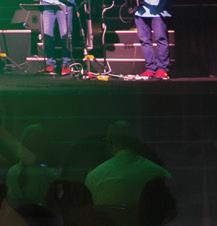




The Salvation Army offers programs in music and arts to teach people of all ages how to sing, play instruments, dance, and act. Whether you’re on the stage performing or in the audience worshipping, you can be part of a lifetime of fulfillment and spiritual purpose. Go to SACONNECTS.ORG to see all we have to offer MUSIC-CONCERTS-THEATRE-DANCE-EVENTS There ’s so much happening. Come and be a part of it ! Experience it All
Fostering God’s Children Fostering God’s Children
by WARREN L. MAYE

“I prayed for this child, and the L ord has granted me what I asked of him.”
—1 Samuel 1:27
illustrationsby JOE MARINO
In Pennsylvania alone, as many as 3,000 young people live in foster care holding centers designed for 48-hour stays. Now more than ever, families are needed nationwide to provide hundreds of thousands of children with loving foster homes, and maybe even adoption

“D
o you want me to be your mom?”
What a strange question to ask of a malnourished 7-month-old infant. But Grace Burke, an experienced nurse who had delivered more than 4,000 babies in her career as a midwife, looked deep into the child’s eyes, held her close, and believed she would answer.
“I could tell I was making eye contact,” said Burke in an interview with SA connects. “I could tell she understood what I was saying.” The little girl’s innocent gaze created a bridge of understanding that went far deeper than mere words. Grace remembers, “She fell asleep in my arms, and we never looked back.”
The child, known only as “Baby” because her birth records were sealed, had been in the home of an elderly couple on Long Island, N.Y. In need of the extra cash foster care provided, they were willing to temporarily house the child. They would put Baby to bed at 6 p.m., then never look at her again until morning.
“I was handed a brown paper bag that had a half-drunk bottle of milk and a Pamper. Nothing else. No clothing, no diapers, no toys. Nothing. They said, ‘Here’s your baby.’”
Still, receiving Baby was a dream come true for Burke. She’d gotten the devastating news from her doctor that, following an unplanned hysterectomy, she and her husband would never have children of their own. As she grieved the loss, she also stopped delivering babies. “It was just too hard to be involved in other couples’ birthing experiences when I, myself, had not healed,” she writes in her memoir Broken Pieces: Mending the Fragments Through Adoption (see book review, p. 30).
Regardless of the circumstances, Burke was elated to have Baby. She celebrated during a shopping spree with her friend Hazel. “We went downtown and just went crazy, buying all the baby clothes and the girly clothes and the shoes—everything that child needed,”
she recalls. “She had her own room. You know, it’s like she went from darkness to light. But she was very traumatized.” Burke observed signs of apparent physical and emotional neglect, as well as the impact that Baby’s birth mother’s substance misuse might have had on the child’s mind and body even before she was born.
A vital need for foster families “Emotional tsunamis over a small disappointment, or a simple request; rage that erupts out of nowhere,” says the narrator of a video on how children react to trauma. “What triggers a teenager to regress to thumb-sucking? Or a sudden emotional shutdown?” In the video, “TBRI ® An Overview: Putting the Pieces Together,” such questions are answered in depth with real-life scenarios. It’s one of many resources available via The Salvation Army Eastern Pennsylvania Children’s Services website (see QR code, p. 26).
Trauma can result from painful or frightening experiences. The memories, bathed in vivid imagination, can keep children in survival mode as they dwell over what happened and the worst of what could have happened.
Angie Gillen, a certified Trust-Based Relational Intervention (TBRI) practitioner
23
“He will turn the hearts of the parents to their children, and the hearts of the children to their parents.”
—Malachi 4:6

and director of education and outreach for The Salvation Army in Allentown, Pa., knows all about how and why these children view their present and future through the lens of a terrifying past. She has seen vulnerable and fragile children cower, scream, or fight when playtime is over, or when their orange juice is finished.
Gillen works to raise awareness in the community about the need for foster and adoptive families to help give kids a better life. She told SA connects that the lack of enough homes for foster care and adoption is at a crisis level.
“In Pennsylvania, there are almost 3,000 kids waiting for adoption,” says Gillen, “but I suspect the problem is nationwide. There’s always been a bottleneck. There’s also been a challenge in finding homes for older kids, and larger sibling groups, and kids with more significant special needs.” Indeed, more than 360,000 children are currently in need of homes according to the Children’s Bureau (U.S. Department of Health and Human Services; see sidebar).
People who might be willing to consider adding more kids to their home are often hesitant because many of the children have experienced trauma such as abandonment or forms of emotional, mental, physical, or sexual abuse. But they should know that there are support systems in place, some of which are covered in the next section.
“People don’t know that there’s a desperate need for foster families. Agencies who are nonprofits and have small operating budgets can’t shoulder the burden of making the entire community aware,” Gillen says. “Kids are usually placed in foster care within the county that they originate from. We’re in Lehigh County and Montgomery County. We serve other counties around there, but we’re getting calls from the other side of the state.”
Gillen remembers one such caller. “I asked her, ‘Do you realize where Lehigh County is?’ She said, ‘Yep, and I called every agency between us and you, and no one has a place now.’”
The opioid crisis is a large contributor to the problem.
“Drugs are just prolific,” Gillen says,
24 Volume 10 Number 4, 2024
“and people struggle with not enough money, support, or resources. They are using drugs and alcohol to self-medicate their mental health challenges. That leads to more kids coming into care. Drug and alcohol misuse is the No. 1 reason kids come into care.”
Seeing through a foster parent’s eyes
The good news is, there are families and individuals who are stepping up to the challenge and opening their doors and hearts to these young people. For more than 20 years, Angela Russell, a single mother of one biological daughter and a graduate of Hunter College in New York City, has served as a certified foster care mother there. Her reputation for offering exemplary care to children and effective recruitment of new foster care families caught the attention of ABC7 Eyewitness News, which featured her in a 2023 special report, “Protect Our Children: Surviving the System.”
“One of the ladies called me and said, ‘Hey, ABC’s running a special on foster care and contacted our agency, and we contacted some kids, and one of your girls was really speaking so highly about you,’” remembers Russell in an interview with SA connects “ABC came with the cameras and turned my house into a studio.” But Russell, who was inspired by her own parents’ willingness to share their home with children in need, wanted the focus not on her but on the people benefiting from the work.
“Being a foster parent has enriched my life so much. I wanted to help out those who were less fortunate in the community, and I saw the need for it. You get to change a person’s life,” Russell told ABC. “When I was growing up, it was mom, dad, brothers and sisters, and other children who just became a part of the family. My mom and dad served as a great example of how I could become a foster parent.
“It is not easy being a foster parent. It’s challenging. Some of the kids have never had a good hug, never had anyone to compliment them. I’ve learned over the years, trying to see things through their lens, learn to build on their strengths. They come in. They are beautiful, broken
children,” Russell said during the broadcast. “See the good in them.”
Russell told SA connects that a flawed system can add to the trauma these young people experience. High turnover of the social workers is a problem.
“Children who have suffered losses shouldn’t have people coming in and out of their lives like that,” Russell says. “If you’ve lost a mom or dad or you’re displaced from your home, and you have one caseworker every week—most times it’s a person from college, they’re not invested into the job—by the time they know the child, they’re gone. Then another person comes. So those are some things that affect the child, and that’s where the trauma can happen. They’re already displaced. They’re already disappointed. Everyone’s disappointed them.”
But Russell is quick to point out that many services and tools are available to assist young people in foster care with educational, emotional, and physical help along their journey to wholeness. “Each of them has a case planner on the team, and they all go to a doctor or clinic. Their records are kept in one place, and they get everything they need. These are not kids who are thrown to the wolves. They get their dental and their glasses. If they manage to go to high school and go to college, they get computers to books to—everything.”
In New York City, for example, the Fostering College Success Initiative (formerly the Dorm Project) helps students in foster care live in dorms and receive life coaching, tutoring, and career counseling. There are also resources for young people who are transitioning from foster care to independent living.
Russell urges foster children to take full advantage of all the programs offered. “Use the therapist, use everything,” she tells them.
“Because once they reach 18 and get housing, once that happens, they’re no longer in care. Then they get a job. They must pay some rent. As soon as they get a better job, their portion of the rent increases. Some of them don’t do better because they’ve never taken advantage of the resources. If they’re in college, they can be in a home.”
Success stories
Good outcomes are possible through foster care. It can lead to successful adoptions. For instance, Colonel Wendy Laxton Morris is currently the president of women’s ministries for The Salvation Army’s Japan Territory. But her life began as a newborn in foster care. She was adopted through The Salvation Army’s adoption agency in New York City and went on to enjoy a blessed family life.
“My parents emigrated from England to the United States in the ’50s. They could not have children of their own. The Army was starting up their work with adoption and foster care in New York,” Wendy says. “My parents were Salvationists. So, they thought, ‘Let’s just go with what we know.’ They went through the processes of having social services visit their home, all that sort of thing.
“They waited quite some time. My mother used to say, ‘It’s women who are only pregnant nine months who don’t understand what it means to wait sometimes eight years to have a baby.’
“But eventually it worked. I was born August of 1965 in Manhattan
BY THE NUMBERS:
Foster care and adoption services in the U.S. in 2022
368,530 children were in foster care.
53,665 children were adopted, 57% of them by their foster parents.
108,877 children were awaiting adoption; 59% had parental rights terminated.
37% of children awaiting adoption were age 4 or younger, 40% were 5–12 years old, and 23% were 13–17.
60% of children awaiting adoption have spent more than two years in foster care; 12% (13,000) have spent five years or more.
6 is the average age at adoption.
2 For every child adopted from foster care, two more were still waiting.
18,538 children aged out of the system, many leaving without the necessary support to succeed in life.
SOURCES: The AFCARS Report/ U.S. Department of Health and Human Services, National Council For Adoption
25 SACONNECTS.ORG
“A father of the fatherless, a defender of widows, is God in His holy habitation. God sets the solitary in families; He brings out those who are bound into prosperity.”
—Psalm
68:5–6 (NKJV )

and brought home in February of 1966.”
Back in those days, the agency kept children until it knew for sure that they were healthy. Wendy was in the foster care system in New York City and doesn’t know where she lived those first six or seven months of her life.
Two years later, her parents also adopted Judy, who was born at Booth Memorial Hospital in Jamaica in Queens, N.Y. The family moved from Jamaica to Long Island, where Wendy grew up attending The Salvation Army in Hempstead. She went to Asbury College and met her husband there.
“We were called to officership, and that’s how I ended up in the Southern Territory, where he is from,” Wendy says.
“We had a wonderful upbringing. My parents were very clear from the time we were young girls that we were ‘hand-picked and specially chosen.’ My parents couldn’t have children of their own, but God provided something incredible by allowing them to adopt a baby. There was a baby out there that needed them as much as they needed her. My sister and I were brought up to understand that this was a very positive experience. As a child, I thought, ‘Well, they must have picked me out of a big bunch of babies.’”
Not everyone shared the family’s vision of adoption. “I must have been about 8 or 9, at the corps, and in Junior Soldier class with my sister and another kid. He whispered to the other kids, ‘Did you know that the Laxton girls were adopted?’” Wendy recalls.
“I remember running to my mother and asking, ‘What’s wrong with us being adopted?’ Obviously, somebody’s family had been talking about this at home. That was one of those turning points where I thought, ‘OK, so not everybody thinks this is great.’”
When Wendy was 13 or 14, a time when teenagers go through all the angst of being

Learning resources for people interested in becoming a foster or adoptive parent
different, she remembers thinking: If my parents really wanted me, then somebody didn’t . I was not chosen by one family for another family to choose me. She had to work through the idea that she’d been given up.
Her sister, Judy Davenport, is also a Salvationist and a member of the Tustin Ranch Corps in California. Today, changes in the law have allowed Wendy and Judy to access their birth records. Modern DNA technology has also made it possible for them to find and reunite with their birth mothers. They now enjoy relationships with them and their families.
Challenges and rewards
Besides Baby, Grace Burke’s 42 years of experience with the foster care system includes two more adopted children who’ve since grown to become biological parents themselves. Years after adopting her children, Burke became the full-time foster mom for her twin grandchildren when their parents were temporarily unable to care for them.
“It was a wonderful time of blessing for my husband and me as well as for the children,” she says. “Five years later, they returned to their parents and are now healthy, thriving young adults.”
Burke, who earned a doctorate in theology, ministers to other families seeking guidance. “I want parents to know that every child has a history file somewhere,” she says. “There are a lot of reasons why they are placed for adoption. Most of the time, the [biological] parent has made the decision that they cannot look after the child for whatever reason. They are trusting they’ll fall into the right hands. But that doesn’t always happen. Some times they get left in group homes until they age out. Unfortunately, they never find an adoptive home. Or they find an adoptive home that’s below par—they really don’t look after the children, they’re doing it for the money.”
Burke points out some important considerations for those thinking of becoming foster or adoptive parents. For one, the biological parents may want to see the baby periodically, or to get pictures or reports on how the child is doing. “The adoptive family must decide, ‘OK, I can live with an
open adoption. Or, you know, I really don’t want the influence of the prior family to make a difference in what I do.”
Sometimes, Burke says, the biological family may search for the child later. They may just want a relationship—but they may even want the baby back. She says potential adoptive parents must ask themselves: “Am I going to be OK with another family claiming responsibility for my child who I adopted, who now has my name?”
Burke says, “When the child gets older, they may want to find the biological family. They may say, ‘I have nothing against my adoptive parents. I love them to death. But I want to know, who are the people who caused me to be in this world? Who gave birth to me? What do they look like? Who are they?’
“How am I going to feel when they connect, if they do? Am I going to help them, or am I going to say, ‘Well, that’s up to you.’”
Is it all worth it?
With so many potential complications, Gillen says, the most important question families should ask but typically don’t is: Does caring for this child, who’s been through so much, really make a difference?
Gillen’s voice seems to rise from deep within her soul when she says, “The answer to that is ‘Yes, it makes an incredible difference. Incredible.’
“Sometimes, foster families only have children for a very short time in their home. Maybe they’re reunified, or they go to a relative. But the fact that they kept them safe and gave them love and security—the impact on those kids is enormous, enormous. It can set them on a trajectory for a completely different future.”
From a purely biblical perspective, we see how Moses was adopted by the pharaoh’s daughter and became the leader of his people (Exodus 2:1–10; 3). Esther was adopted by her cousin and became a queen who helped save her people from annihilation (the Book of Esther). Jesus was adopted by His earthly father, Joseph, and became the spiritual Savior of the entire world (New Testament). Foster care and adoption can— and they do—make a difference.
26 Volume 10 Number 4, 2024


Go to sastores.org to locate a Salvation Army family thrift store near you.
by HUGO BRAVO
Gear up for summer with The Salvation Army
Planning an afternoon with friends at the park or a lazy day at the beach? Your Salvation Army thrift store has what you need. Stop by to find everything from outdoor chairs and a cooler to toys and totes, just like we did, and let the fun in the sun begin!
Every purchase you make at a Salvation Army thrift store helps fund local Adult Rehabilitation Centers, where people who are struggling from a variety of social and spiritual problems can find help and hope. Visit SArehab.org to learn more.
27 SACONNECTS.ORG RECOVERY THRIFT STORE FINDS
What to Do with Feelings
Anger, sadness, joy, fear, disgust, surprise—how do you respond to runaway emotions?
by ERIN MORGAN

A familiar feeling comes over me as I remember the sounds of a tinkling piano, the sight of sneakers and a cozy cardigan, and the familiar warm face of a friend singing, “What do you do with the mad that you feel?” My friendly neighbor on the TV, Mister Rogers, talks about how toys don’t have feelings, but people do.
That’s a simple truth. It's not earth shattering. Of course, people have feelings! But what do we do with them? What do we do with the mad that we feel? Or the sad that we feel? Or the joy that we feel?
Mister Rogers’ advice is as follows: “It’s great to be able to stop/When you’ve planned a thing that’s wrong.” Are you able to stop, to pause—to take a moment and recognize the feeling you’re experiencing and then choose what to do next?
There are seasons where stopping takes immense courage—seasons of challenges or grief. In these seasons, I will push myself to keep moving to avoid the realities I live
in. I try to keep moving so quickly that the depth of grief or struggle I’m facing is not able to sink in.
Let me say from experience this is not the best response. Inevitably, these feelings and the reality of what is going on will catch up with the running and the avoidance, leaving me struggling and worn down.
Time to pause
In other seasons—the good moments—we want to press the pause button and remain there forever. A little over a year ago, I had my first baby. She is now growing faster than I am ready for. Everyone warns me
that the process goes too fast. The struggle and exhaustion of being a new parent can prevent us from recognizing the beauty that we’re living in. Those are the moments that we’ll look back on and wish we had stopped to enjoy the giggles, the first words, and the snuggles.
Someone once told me that you can’t control what emotions you feel, but you can control what you do with them. Mister Rogers echoes this sentiment by urging children to stop when they feel mad. In Scripture, we find this advice: “My dear brothers and sisters, take note of this: Everyone should be quick to listen, slow to speak and slow to become angry, because human anger does not produce the righteousness that God desires” (James 1:19–20).
There is no way to be alive without experiencing highs and lows, but we must challenge ourselves to slow down, pause, stop, and be mindful of our choices. Ecclesiastes
28 Volume 10 Number 4, 2024
SPIRITUAL LIFE DEVELOPMENT
LIVING

talks about the different seasons that we live through. It says, “There is a time for everything, and a season for every activity under the heavens:
a time to be born and a time to die, a time to plant and a time to uproot, a time to kill and a time to heal, a time to tear down and a time to build, a time to weep and a time to laugh, a time to mourn and a time to dance, a time to scatter stones and a time to gather them, a time to embrace and a time to refrain from embracing, a time to search and a time to give up, a time to keep and a time to throw away, a time to tear and a time to mend, a time to be silent and a time to speak, a time to love and a time to hate, a time for war and a time for peace.”
We will live through many, if not all, of the seasons listed in this passage. But we can be assured of this promise Jesus gave His disciples in Matthew 28:20, “Surely I am with you always, to the very end of the age.” God is with us no matter how dark the season or how hopeless we may feel. Our responsibility is to stop or pause, recognize where and how His presence is near us, and choose how we move forward. So, as Mister Rogers asked, “What do you do with the mad that you feel?”
RESOURCES
Spiritual Direction
Spiritual Direction is a “companioning” practice that explores the quality of one’s communication and connection with God. It is beneficial for everyone who wonders about how God works in their lives and who is trying to pay closer attention to Him. The focus is to prayerfully notice how God is speaking. God uses Spiritual Direction to invite us to live more attentively to His guidance. This affects our ability to recognize God in ourselves, others, and the world. The recognizings are God’s invitation, and our work is to be intentional about responding. There are two individuals involved in a Spiritual Direction relationship: “director” and “directee.” The director is trained to guide the conversation through prayerful discernment and faithfulness from the Holy Spirit. The directee shares what they hear from God and experience within their sacred relationship with Him. There are times of joy and pain, of growing deeper in relationship with God, and there can be the feeling of not hearing anything from Him. These are all explored by working through the opportunities and challenges being presented with God.
USA East Spiritual Life Development provides various spiritual formation resources and an on-staff spiritual director, Joanna Polarek ( joanna.polarek@use.salvationarmy.org ). She has her certificate in Spiritual Direction (see sidebar). Here are some trusted websites for discovering more information and finding a spiritual director: Leadership Transformations Inc. leadershiptransformations.org/spiritual-direction Grafted Life Ministries graftedlife.org
FREEPIK 29 SACONNECTS.ORG
Mending Hearts
An intrepid mother who raised three adopted children shares her challenges and rewards
by WARREN L. MAYE
Broken Pieces: Mending the Fragments Through Adoption gave me chills and provoked tears of pain and joy, even as some aspects confused me.
Though I have firsthand knowledge of the author’s incredible story, I must admit that being Dr. Grace Allman Burke’s brother-in-law (her sister and I are married) didn’t stop me from scratching my head a few times as I tried to understand why she would write it using pseudonyms for the characters including herself.
I kept asking myself, Why doesn’t she just tell readers that this is about her own family? What’s with the made-up names?
But I learned that to protect her children from stigma, she believed this strategy was necessary at the time. “I got the children’s permission to write the book, but I did not use their names,” she said in an interview with SA connects
Protecting the innocent
Burke wrote the book in the first person but chose to conceal the narrator’s identity under the name “Giselle Gillman Bishop.” She also didn’t call it a memoir. Still, the content came directly from her diary, where she faithfully kept copious notes through the years.
“This is what happened,” she said.
Today, this award-winning author makes her role in the story crystal clear. “I tell everybody who comes to the book table that this is my memoir,” Burke said. “I’ve opened that door now. It doesn’t matter. My children are grown and gone. So I’m open about it.”
Burke dedicated Broken Pieces to adoptive mothers. “I want to tell these women, ‘Thank you for taking on this responsibility. It’s not an easy job. It’s sometimes very thankless,’” she said.
In her message to adoptive mothers
“who didn’t carry their babies under their hearts, but rather, within their hearts,” she concludes, “You deserve more praise than words can express. Your work hasn’t been in vain, and this book is written in honor of you.”
Serving God, saving lives
In 2023, Burke was honored by the Alumni Association of Cornell University–New York Hospital School of Nursing, her alma mater. She was recognized for writing six books and for her outstanding achievements in nursing and midwifery. Burke is also an ordained minister.
Alumni Association President Linda V. Saal said, “Despite racial discrimination and other unpleasant adversity, she not only delivered over 4,000 babies, which is just mind-boggling, but also her most excellent skills saved the lives of babies who otherwise could have died.
“Most of all … I see Grace as someone who inspires others to never give up, to speak the truth, and to help others. Her deep devotion and belief in God have supported her through the many challenges in her life.”
Beyond broken dreams
Those challenges are hinted at on the book’s cover, which pictures a red heart, fragmented into five pieces. Each jaggededged shard represents a member of her immediate family—two high-spirited daughters, one quiet but persistent son, a remarkably enduring husband, and Grace.
“This union of such diverse individuals was ordained according to God’s divine plan,” Burke writes. In a chapter titled “Broken Dream,” she describes how her heart was broken when an unplanned hysterectomy abruptly ended her dream of bearing children of her own.
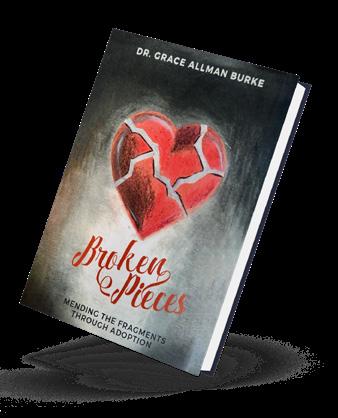
in this page-turner, Burke reveals more of their unique and sometimes disquieting personalities. The settings are vivid, ranging from New York City to Dallas, Texas, to Barbados in the West Indies, and along the way she addresses many questions about the challenges and rewards of adoption.
The contents are divided into four parts titled Breaking, Blending, Gathering, and Mending. Each takes the reader deeper into the metaphor of brokenness with evocative chapter headings—“Splinters,” “Slivers,” “Fragments,” “Patches,” “Chips”—that describe real-life trauma as the children struggle to mature.
Family legacy
The greatest reward Burke enjoys today is seeing her family grow to include grandand even great-grandchildren. “You know, at the end of the day, there are 13 of us now. We’re very close knit and we spend holidays together. They say they’re not leaving Texas while my husband and I are alive,” she said.
“It wasn’t always that way, but now they’re adults in their 40s and experiencing their own situations. I’m trying to see what I can do to make sure the next generation may not experience some of the things that we did.”
Broken Pieces: Mending the Fragments Through Adoption shows how a Godinspired mix of love, fortitude, hard work, and faith can help strengthen life’s most fragile relationships and give new meaning to the definition of family.
Broken Pieces: Mending the Fragments Through Adoption, in Kindle and paperback editions, 258 pages, is published by GAB Enterprises, Prosper, Texas, in partnership with CreateSpace Independent Publishing Platform. It is available on Amazon.com.
30 Volume 10 Number 4, 2024 LIVING BOOK REVIEW
A Season of Wellness
by HUGO BRAVO
Beat the heat and make healthy habits part of your summer routine with these 10 tips
1 WEAR SUNSCREEN This is the Golden Rule for a healthy summer (though you really should wear sunscreen year-round). Choose one marked SPF 30 or higher, and look for the words “broad spectrum” and “water resistant” on the label. Apply liberally every two hours, and don’t forget easy-to-miss spots like your ears, feet, and scalp or hairline. But if you do forget your sunscreen …
2 TREAT SUNBURNS IMMEDIATELY Alleviate the pain with cool baths or low-pressure showers, and follow up with a moisturizer that has soothing ingredients like aloe vera or oatmeal. You can take a pain reliever such as ibuprofen to help with redness or swelling. Sunburns draw fluid to the skin’s surface and away from the rest of your body, so make sure you...
3 STAY HYDRATED The combination of heat and outdoor activities can lead to dehydration, so drink plenty of water throughout the day. Avoid alcohol and caffeinated drinks, which can make you thirstier. If you crave something besides plain water, try sparkling or add a slice of fruit or cucumber for a burst of flavor. Always having water nearby is a great way to …
4 KEEP YOUR COOL Make sure your home’s fans, air conditioners, or central air units are clean and working properly. Try to be in the shade as much as possible. For a quick cooldown, soak a washcloth in ice water with a few drops of essential oil for fragrance. Squeeze out the excess water and apply the cloth to your face. Keep a cold one close for when you …
5 WORK THE GRILL Hot dogs and burgers are a summer tradition, but try to include proteins like skinless chicken, turkey breast, or fish. Trim the fat off any meat you prepare and let it marinate for at least 30 minutes before grilling. Serve fresh seasonal fruits and vegetables, or grill them for new flavors. A good summer diet will give you the energy to …
6 STAY ACTIVE Try to get at least 150 minutes of moderate-intensity exercise each week. Not sure what that means? If you can talk, but not sing, while you’re moving, you’re in the right range. Swimming, dancing, bicycling, and brisk walking or jogging are great options. If possible, exercise in the morning or late afternoon, when the weather is usually cooler. Remember to drink plenty of water, and if you’re outdoors …
7 WATCH OUT FOR BUGS To keep mosquitoes and other pests away, use an insect repellent that contains DEET. Spray yourself in a well-ventilated area. Unlike sunscreen, applying once is usually enough. If you do get bitten, most bug bites go away on their own, but see a medical professional if you experience fever, chills, body aches, or severe swelling in the bitten area. You can also avoid insects if you …
8 DRESS APPROPRIATELY Going on a summer hike in the woods? Wear pants and long socks to ward off nasty ticks. Protect your eyes with sunglasses that block 99% to 100% of UVA and UVB light. Flip-flops are popular, but most are too flimsy to wear for long periods. Save them for the pool or beach, and opt for comfortable sneakers made from breathable materials. And have a fresh pair ready for when you …
9 TAKE A VACATION Long periods in a car or airplane can drain your energy, no matter how exciting your destination might be. Take breaks to stretch and walk during long road trips, and pack your own healthy snacks for the plane ride. If you’re staying at a hotel, make use of the gym facilities, or find a workout you can do in your room with an online video or a phone app. And above all …
10 PRIORITIZE YOUR MENTAL AND SPIRITUAL WELL-BEING We tend to associate depression and stress with winter. But summer can also come with changes in our routine or pressure to make the most of the days. Remember that all seasons are a gift from God, and there is a season for every activity under the heavens (Ecclesiastes 3:1). Make time for self-care and activities that bring about peace and clarity, such as Bible study, art, or journaling.
FREEPIK 31 SACONNECTS.ORG LIVING HEALTH
VOLUNTEER SPOTLIGHT
by HUGO BRAVO
It takes place just two days per year, once in the spring and again in the fall. But Deborah Kazar knows that the Fabric Fair is a year-round ministry for her and other volunteers with The Salvation Army Greater Pittsburgh Women’s Auxiliary.
“The Fabric Fair was my introduction to The Salvation Army,” says Deborah, who is vice president of the Greater Pittsburgh Women’s Auxiliary. “I make purses and go to many fairs like this for material. But here, they asked me if I wanted to volunteer, and so I started coming on Wednesdays to help The Salvation Army.”
Since its inception over 30 years ago, the Fabric Fair has raised nearly $750,000 for The Salvation Army to help individuals and families in Allegheny County, Pa.
Throughout the year, the Women’s Auxiliary collects fabrics, buttons, zippers, and more, organizes the logistics, and promotes the fair over social media. Items are sold at a fraction of their cost at large stores. It’s a ministry dependent on both the donations it receives and the work of its volunteers. They do everything from labeling boxes of supplies to watching videos on how to fix old sewing machines to make them usable again and salable at a profit.
Deborah arrived at the Fabric Fair just as its chairperson of 15 years retired. None of the fair’s numbers or procedures were written down because the chairperson had memorized all the information.
“When we received pallets full of fabrics that needed to be measured, there was no system for organizing what we got,” Deborah says. “We were still using old baby scales for weighing materials and doing the pricing with pen and paper. It was time to move on to digital tools that did the pricing for us.”
As a U.S. Army veteran and former schoolteacher, Deborah knew that better structure and order would lead to better results. Changes ranged from tweaking how they showed off products, like displaying zippers
“We’ve thought about turning the Fabric Fair into a whole weekend event, or maybe charging a fee to have early access to our products,” says Deborah Kazar. “But that would require our volunteers to be here an extra day or two. These are women in their 70s and 80s, and they’re already working hard year-round to make that one day of the fair into a big success.”
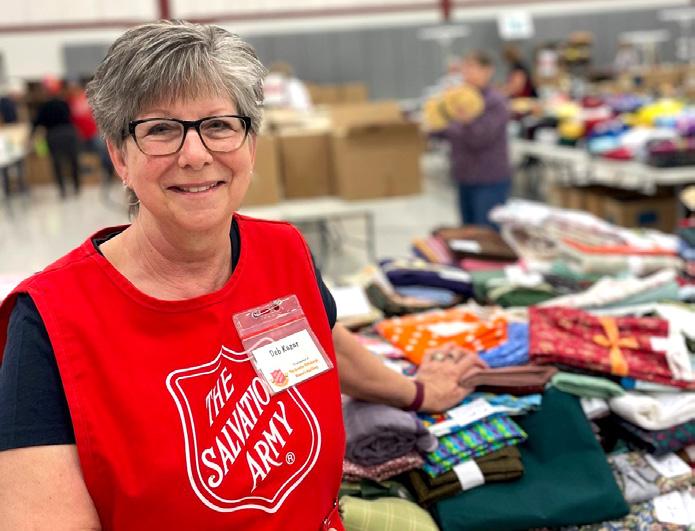
on hangers rather than in boxes, to buying tools to make handling fabrics easier.
“We bought a fabric roller from Grand Rapids, Mich.,” says Deborah. “It was originally used in Detroit car factories for the interior fabrics. The Salvation Army in Michigan bought it for themselves, and when they had no use for it, they sold it to a couple that also worked in fabrics. We bought it from them.”
To store its merchandise, the Women’s Auxiliary shares space at a warehouse with the Army’s Western Pennsylvania Division Emergency Disaster Services (EDS). Deborah and other Women’s Auxiliary members also volunteer to prepare food on Tuesdays, when the EDS canteen goes out to feed Pittsburgh’s unhoused community.
The warehouse facility has a small modeling room where the women can take pictures of products to post on social media. They split the cost of display tables with the local Salvation Army summer camp. Sharing is never a problem; the fair and the camp use the tables at different times of year. In turn, if the camp needs curtains for cabins or tablecloths for its dining room, they are
welcome to come and find materials.
“Nothing goes to waste. Even scraps of fabric too small to sell go to people that make supplies for pets,” says Deborah. “We’ve met folks from charities that make clothing and purses for others. One group buys fabrics to sew menstrual pads for women in poor parts of the world, where those hygiene products are expensive or difficult to find.”
A new, younger generation—familiar with websites like Etsy and starting home businesses—is embracing sewing and other handicrafts, and the fair is a great resource for them. High school theater clubs with limited funds know that at The Salvation Army, they can afford supplies for costumes and backgrounds. Local fashion designers and models come to find materials for their next runway show. They don’t have to wait to get what they need; some even take the time to volunteer at the warehouse.
“College kids today are crocheting, sewing, and scrapbooking!” says Deborah. “For them, our Fabric Fair ministry is their introduction to what The Salvation Army does, as it was for me.”
32 Volume 10 Number 4, 2024
NICOLE HARRELL
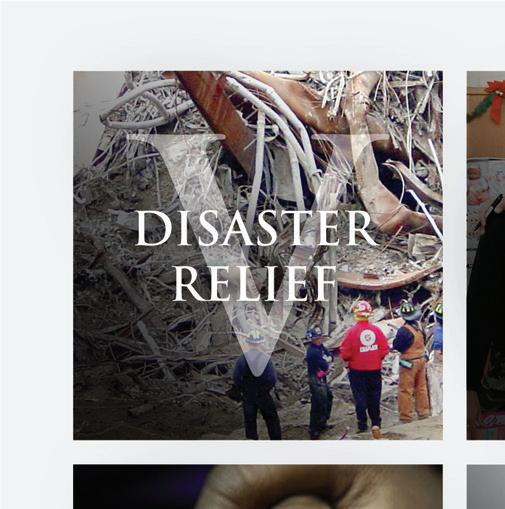


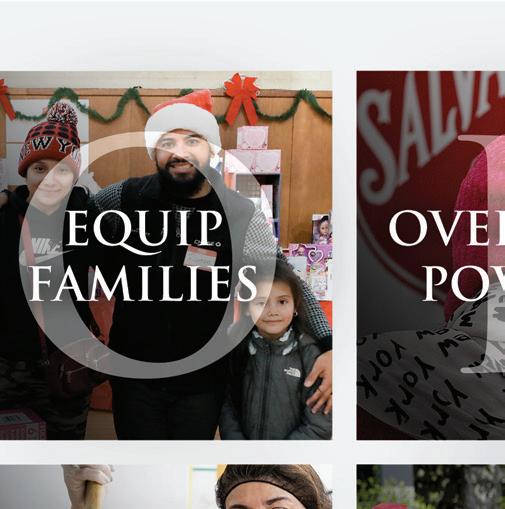






Learn more at easternusa.salvationarmy.org — Albert Einstein “Only a life lived for others is a life worthwhile.”
If you’re looking for a place to worship, we invite you to join us. To find a location near you, go to easternusa.salvationarmy.org and enter your zipcode and view the map, or select Worship Center from the dropdown options.









 WARREN L. MAYE Editor in Chief
WARREN L. MAYE Editor in Chief

















































































































